Australian florin date varieties
1911
Type 1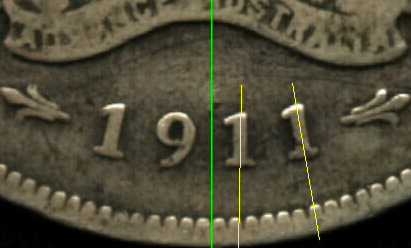
Enlargement of the date portion of the first 1911 florin showing the upright orientation of the second 1 and its alignment neither directly over a rim denticle nor directly over the gap between denticles.
Type 2
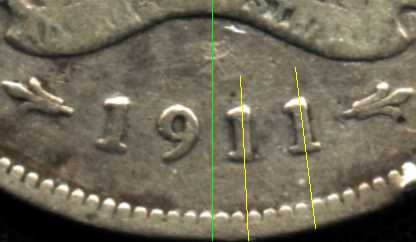
Enlargement of the date of the second 1911 florin above showing how the second 1
in the date is tilted slightly and is aligned directly over a gap between two rim
denticles.
1912
Type 1
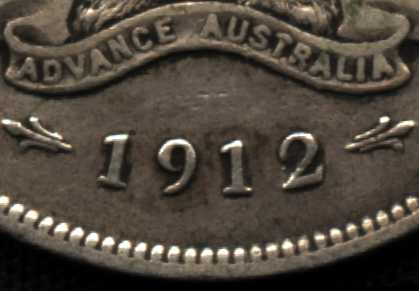
Enlargement of the date portion of the first 1912 florin showing the position of the second 1 directly over a rim denticle.
Type 2
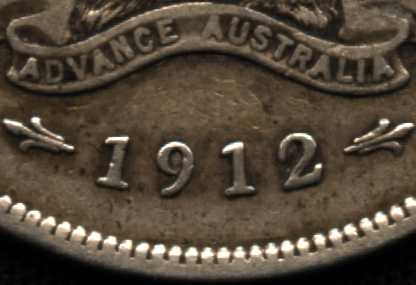
Enlargement of the date of the second 1912 florin above showing how the second 1
in the date is tilted slightly and is not aligned directly over a rim denticle.
1913
The 1913 florin occurs in at least two varieties. One has a fairly upright 13 and the other has the 13 sloping slightly more to the left but the difference is very subtle. Another distinguishing feature is the alignment of the second 1 in the date with the rim denticles below it. On the latter variety, the 1 is squarely over a denticle whereas on the latter the 1 is slightly offset and aligned more over the gap between two denticles. Overall, it seems to me that the date is slightly wider on the latter variety but I lack the means to verify that assertion.
There may be a third variety, similar to the first mentioned above, but with the second 1 closer to the centre line of the coin.
Type 1
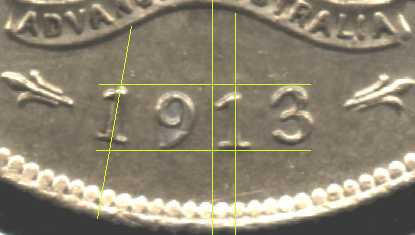
Second 1 in date is almost perfectly upright (it leans ever so slightly to the right) and is positioned slightly to the left of a rim denticle.
Type 2
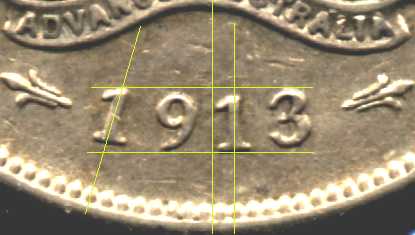
Second 1 in date leans ever so slightly to the left and is positioned squarely over a rim denticle. (The line to the right of centre is vertical and the 1 is seen sloping
behind it.)
Type 3
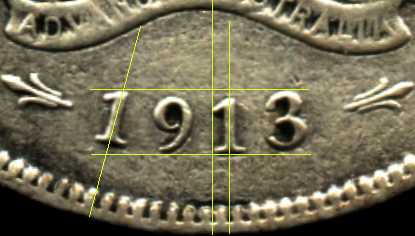
Similar to the first variety in that the second 1 of date is upright but the
1 is closer to the centreline of the coin and is aligned directly over the gap between
two rim denticles.
1914
Part of the job of minting the 1914 florins was given to Heaton & Sons of Birmingham and coins from the Heaton mint display an H on the reverse below the date. The coins struck at the Royal Mint in London occur in two varieties distinguishable by the spacing and alignment of the numerals in the date.
The existence and nature of the London varieties poses an interesting problem. It is my understanding that it was common practice at the Royal Mint for the engravers to hand-punch the last one or two digits of the date directly onto the working dies. Presumably this practice was considered more economical in the days when mintages were fairly small (less than 5 million coins) than the alternative approach of preparing a fully dated master die and then pressing a working punch. Now since the two varieties of the 1914 London florin have different spacing between the first two digits of the date, they cannot have been struck from working dies made from the same 19-- or 191- master tool. Does this mean that there were two master punches for the early Australian Commonwealth florins?
Type 1
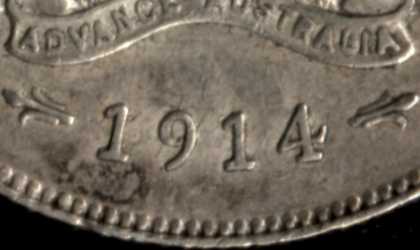
Normal (wide) date. Second 1 is positioned directly over rim denticle 82.
Type 2
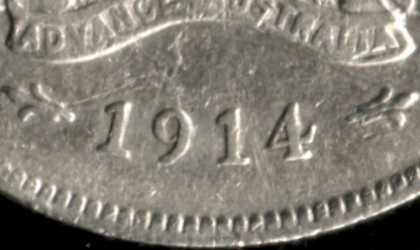
Narrow date. This seems to be a fairly scarce variety. The 9 is closer to the first 1, the second 1 is positioned over the gap between rim cles 82 and 83 and the 4 is further from the right arrow.
Type 3
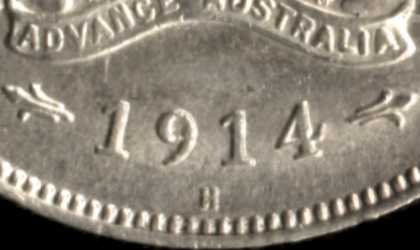
Mint mark H below date. Same as the first of the London varieties except for the addition of the mint
mark.
1919
There are several die varieties of the 1919 florins and the varieties are very difficult to classify.
John Dean lists three varieties
which differ according to the slope of the nines in the date and the position of
the second 1 with respect to the mint mark and provides photographs. Robert Clarke also lists three varieties but
he is rather cryptic in is descriptions of the variations:
a First 19 close
b Wide date
and doesn't elaborate or provide a picture. In my own collection I have eleven specimens
of this coin and they represent at least six varieties. That is an extraordinary
number for such a small sample.
Obviously, my 1919 florins were struck by six different coining dies and the differences in the coins reflect differences in the dies. There is something rather peculiar about the 1919 issue. There are no observed or reported varieties of the 1916, 1917 and 1918 florins suggesting in each case that a single derivative master die had been made, then a punch which was used to create the working dies. In 1919 there may have been a departure from that practice, and a reversion to the technique apparently used in the Royal Mint for the earlier issues where the final two digits of the date were hand-punched onto the working dies. This regression may have been prompted by the planned issue, which was lower than any of the three earlier Melbourne minting.
Type 1
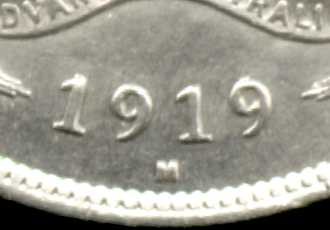
Second 19 slopes left. Second 1 directly over rim bead.
Type 2
Second 19 slopes left. Second 1 over gap between rim beads.
Type 3
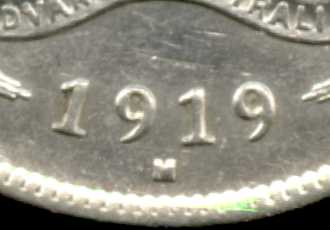
2nd 1 (nearly) upright and positioned over a rim bead. 2nd 9 slopes left.
Type 4
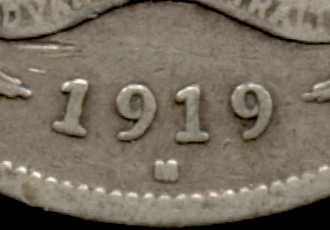
2nd 1 upright and positioned over the gap between two rim beads. 2nd 9 slopes
left. 2nd 1 close to 1st 9.
Type 5
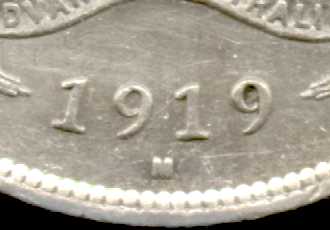
2nd 1 slopes slightly right. Both 9s slope right. 2nd 1 over rim bead.
1931
This is the second most common of the George V florins. Only the 1936 florin
was minted in larger numbers.
John Dean lists two varieties of this florin, one with flat-base lettering on the reverse legend, the other with curved-base lettering. Robert Clarke offers a very terse description of a variety
"Short figures in date"
I believe these two descriptions refer to the same (variety) coin and that the "short
date" was the result of the same sort of die/punch distortion that caused the
fishtailed legend. There are three observations to be made from a study of 1931
florins:
-
The vast majority of 1931 florins do not have fishtailed lettering,
-
All the "short date" coins have fishtailed letters and conversely all
the coins with fishtailed letters have short dates,
-
The final 1 in the short date has a "normal" shape just like the 1s in
a normal 1931 florin.
This leads me to the conjecture that the variety coin was made from a late derivative
tool while the main production issue was made with dies remastered from the 1923
tools. That is definitely a subject for further investigation.
High-grade forgeries of the 1931 florin exist.
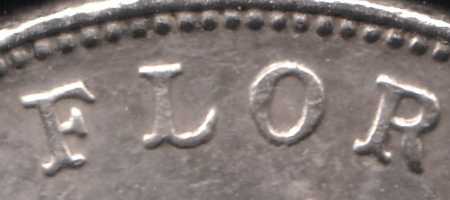
Heavy fishtailing on the legend of the "short date" florin. The short
date is likely to have been produced by the same process that fishtailed the letters,
i.e. distortion of a working punch or of the die from which it was derived.
Type 1
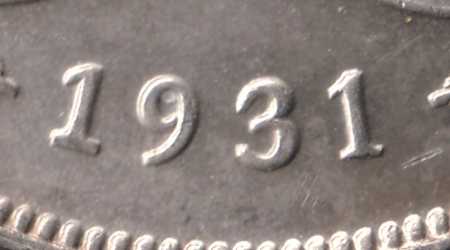
31 tilted strongly to the left with the 1 close to the 3. Final 1 aligned directly over a gap between rim beads.
Type 2
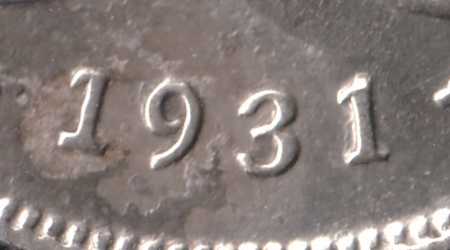
3 upright, final 1 not so tilted and further from the 3. Date numerals are not
so tall. Final 1 aligned (almost) directly over a rim bead.
1946
The 1946 florin occurs in two varieties. The common variety is illustrated below. The 6 in the date is the same as that on the 1956 florin. The second variety has a 6 with a larger circle, like those on the florins of the sixties.
Type 1
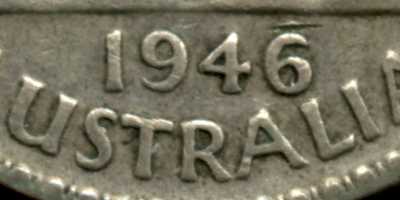
6 has a small circle. Same 6 as on the 1956 coin.
Type 2
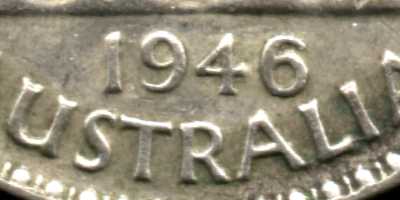
6 has a large circle like those on the 196X coins.
Other Australian coins varieties
Mintmark variations of the 1942 San Francisco florin
Letter-shape variations of George V pennies

